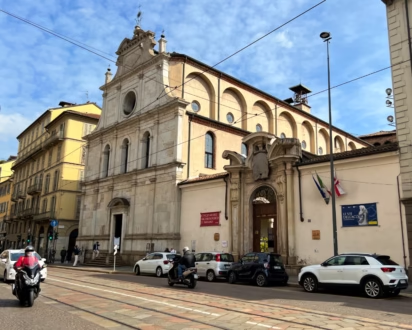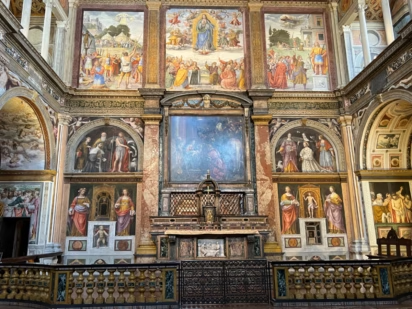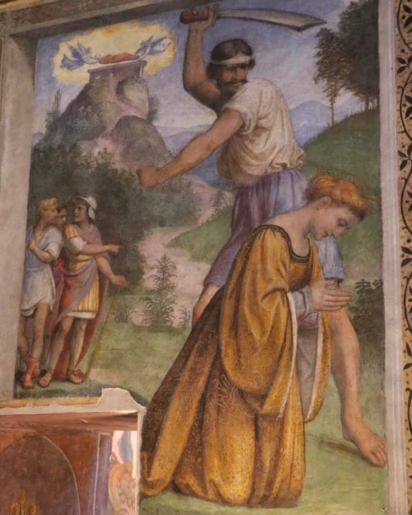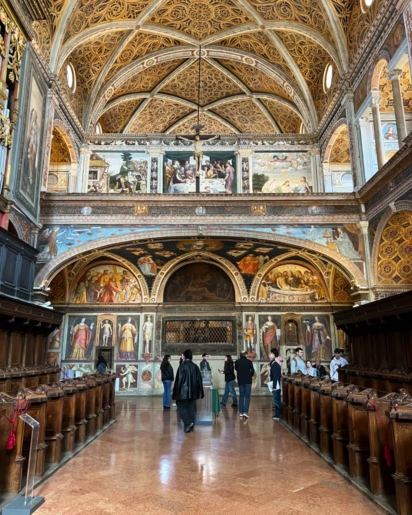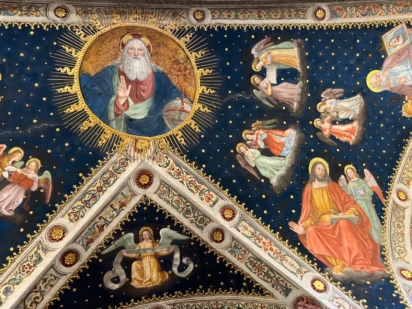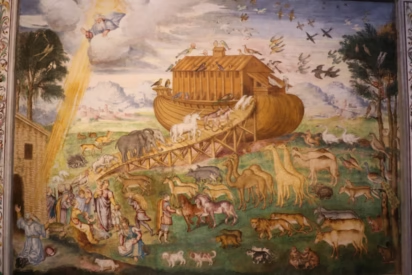The Renaissance Chiesa di San Maurizio al Monastero Maggiore di Milano (Church of St Maurice) is a top free sight to visit in Milan. Behind the plain facade hides the “Sistine Chapel of Milan” with every interior surface colorfully covered with 16th-century frescoes, paintings, carvings, stucco, and decorative details.

A visit to San Maurizio Church is a fantastic addition to any art or cultural trip to Milan. Only two blocks from The Last Supper and a short stroll from the Duomo, the most remarkable Renaissance frescoes in Milan decorate the small church of St Maurice. Behind the plainest of grey facades, the “Sistine Chapel of Milan” is a delightful surprise offering visitors more art than many cathedrals. A visit to San Maurizio in Milan is free and without tickets or reservations. Guided tours in combination with The Last Supper are occasionally possible.
San Maurizio al Monastero Maggiore in Milan
The Church of St Maurice in Milan (Chiesa di San Maurizio al Monastero Maggiore di Milano) was for centuries the church of the main female Benedictine convent in Milan. Its origins go back to the 8th century but the current Renaissance church was erected between 1503 and 1518 with the facade only completed in 1574. Much of the magnificent art survived from the 16th century making this small church a top free sight to see in Milan.
The church follows a relatively simple plan: a single-nave rectangular hall with side chapels. The hall is still divided by a rood screen, which allowed the general public and the nuns to celebrate mass simultaneously but without coming into any inappropriate physical, or even direct visual, contact. Although the monastery was dissolved in 1798, the rood screen and division survived but most of the large monastery complex was destroyed.
Frescoes and Art in San Maurizio Church
Nothing of the rather plain, simple Renaissance greystone facade of San Maurizio hints at the colorful abundance of art and decorations inside this small church. Although “Sistine Chapel of Milan” is a bit oversell, no other church except the cathedral, offers as much art in Milan.
Some of the best Milanese artists of the 16th century worked on the decorations in the church, although these artists are currently not as famous as their Florentine and Roman counterparts. Some of the earliest frescoes are by Bernardino Luini and Giovanni Boltraffio, a pupil of Leonardo da Vinci. Further works from the second half of the 16th century are by Antonio Campi, Simone Peterzano, and Bernardino Luini’s three sons.
Visiting San Maurizio in Milan
Visitors to the Chiesa di San Maurizio enter the front hall of the church directly from Corsa Magenta street. A narrow passage next to the altar leads to the nuns’ hall behind the separation wall. The exit from the nuns’ hall is via the cloisters of the adjacent archaeological museum.
A one-way system is enforced in the passage between the two halls. To return to the front hall from the nuns’ hall, it is necessary to exit via the cloisters and re-enter the church from the street.
Guided tours in English are rare and usually an add-on to longer Milan walking tours and visits to the nearby The Last Supper and Santa Maria delle Grazie. Basic signs in English and Italian identify most of the artworks and artists.
Hall of the Faithful
The rood screen (dividing wall) behind the altar in the front hall, or Hall of the Faithful (Aula dei fedeli), is decorated with frescoes painted by Bernardino Luini probably around the time of construction of the church. At the top level, from left, the Martyrdom of St Maurizio, the Assumption of the Virgin, and St Sigismund Presenting St Maurice with the Church.
The frescoes on the lower levels are of various saints (described in Italian and English). Note the painting of the two sponsors of the decorations in the two lunettes: Alessandro Bentivoglio and his wife Ippolita Sforza. Four of their daughters were in the convent with Alessandra being abbess six times. The extended family is portrayed in various other frescoes in different chapels.
The alter painting is the Adoration of the Magi (1578) by Antonio Campo. This painting was added later and probably replaced an earlier crucifixion scene.
The church’s rear wall has two large frescoes by Simone Peterzano (1573): The Return of the Prodigal Son and Clearing of the Temple.
Hall of the Faithful Side Chapels
Most of the main frescoes in the eight side chapels are of the Passion of Christ and were painted by the three sons of Bernardino Luini: Aurelio, Giovani Pietro, and Evangelista.
However, the third chapel on the right, the Chapel of Saint Catherine of Alexandria (or Besozzi Chapel), was the last major work by Bernardino in 1530. His Christ at the Column is the main work but many visitors prefer the gossip related to the two frescoes on the life of St Catherine. According to tradition, the face of St Catherine in the decapitation scene is that of the Countess of Challant, who was beheaded in Sforza Castle in 1526 after having been condemned for arranging the murder of her lover.
The third chapel on the left, which gives access to the passage to the Hall of the Nuns, has the Baptism of Christ as the main fresco. The influence of Leonardo da Vinci is clear in the angels. Leonardo’s The Last Supper also influenced the frescoes in Deposition from the Cross Chapel, from which the passage leads to the second half of the church.
Hall of the Nuns

The hall of the nuns (Aula delle Monache) is equally richly decorated as the front hall but adds further interesting furnishings and architectural details. Most notable are the choir stalls (1540) of the nuns and the magnificent organ (1557).
The oldest frescoes in the church are on the vaults of the arch of the pier against the dividing wall. These are probably by the workshop of Vincenzo Foppa and in an older style than the rest of the church. It has a midnight blue sky with golden stars, God the Father, the Evangelists, and musical angels.
The grate in the dividing wall allowed the nuns to follow the mass while two small openings lower on the wall allowed for the passage of the host and the adoration of the sacrament.
The frescoes above the pier and on the back wall with scenes from the Passion of Christ are by Bernadino Luini’s three sons. The Last Supper on the rear wall was clearly inspired by the more famous one in the refectory of Santa Maria delle Grazie. (The meal scene painted above the pier is the Wedding at Cana.)
Many of the original frescoes in the side chapels were lost and replaced by landscapes painted mostly in the 20th century. However, a notable exception is the rear chapel on the right. The scenes from Noah and the Ark are attributed to Luini’s youngest son — Aurelio — who was influenced by Flemish artists. The opposite chapel has Old Testament scenes including the Original Sin and the Sacrifice of Isaac.
The organ was created in 1554 by Giovan Giacomo Antegnati and was restored in 1982 to its original condition. The entire transmission is mechanical using a 50-note keyboard and 20 pedals.
Opening Hours to Visit San Maurizio in Milan
The opening hours of San Maurizio in Milan are relatively long: Tuesday to Sunday from 10:00 to 17:30 (last admission at 17:00).
Admission to San Maurizio for individuals is free and without tickets or timeslot reservations. At really busy times, there may be some waiting as only 40 persons are allowed into the front hall and 55 into the nuns’ hall at any given time.
Reservations are essential (and free) for groups (8 to 30 persons).
Small backpacks may be carried in front or by hand. The church has no luggage storage or toilet facilities. Book luggage storage in Milan online.
Transportation to Visit San Maurizio Church in Milan
Getting to San Maurizio is easy from most parts of Milan. It is at Corso Magenta 15, 20123 Milano, next to the small Civic Archaeological Museum. (The small Gelato Fatto Con Amore across the street is highly recommended.)
Walking from the Duomo takes about 15 minutes, or use tram 16 towards San Siro Stadio. The closest metro stop is Cadorna (Lines 1 or 2 / red or green).
San Maurizio is only about two blocks from The Last Supper Museum and Santa Maria delle Grazie. It is a short walk from the Sforza Castle, the Pinacoteca Ambrosiana, and the Leonardo da Vinci National Museum of Science and Technology.
More Tips on Milan Sights and Tickets
- Top Leonardo da Vinci Sights and Art to See in Milan
- The Last Supper by Leonardo Da Vinci:
- How to Buy Tickets for the Last Supper,
- What to Expect when Visiting the Last Supper Museum,
- Tips on How to Buy Tickets or Book Tours for the Last Supper Museum — buy early or only guided tours are available,
- How to Get Free Tickets for The Last Supper and a step-by-step guide for booking free Sunday tickets,
- Booking Guided Tours of The Last Supper at GYG.
- Visit Chiesa di Santa Maria Delle Grazie — admission to the church next to The Last Supper Museum is free.
- Visit the Free San Maurizio Church — endless Renaissance frescoes in the “Sistine Chapel of Milan”
- Visit the Pinacoteca Ambrosiana to See Leonardo Da Vinci’s Musician Painting and the Codex Atlanticus.
- Visit the National Museum of Science and Technology Leonardo da Vinci
- Milan Duomo Complex:
- Cheapest Public Transportation to Milan Malpensa Airport (MXP).
- Book luggage storage in advance — close to transportation hubs is generally the better option.
- Book Last Supper Tours at Viator.
- Book Guided Tours for the Duomo, Last Supper, and other sights in Milano from Get Your Guide.
- Buy Admission Tickets for the Duomo and top sights in Milan from Tiqets.
- Buy Milan Guidebooks at Amazon.

